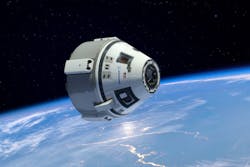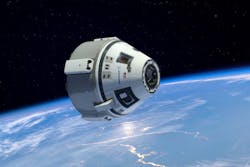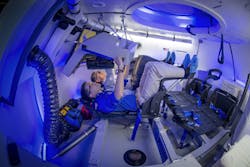Boeing selects Aerojet Rocketdyne to support human spaceflight in U.S., carry Americans to ISS
SACRAMENTO, Calif., 24 Nov. 2015. Aerojet Rocketdyne (NYSE:AJRD) won a nearly $200 million Boeing contract that supports a new era of spaceflight: carrying humans to the International Space Station (ISS) from American soil. Under its Commercial Crew Transportation Capability (CCtCap) subcontract to Boeing, Aerojet Rocketdyne engineers are designing, developing, qualifying, certifying, and undertaking initial production of the Crew Space Transportation (CST)-100 "Starliner" service module propulsion system.
Aerojet Rocketdyne's work continues the development of the service module and launch abort propulsion system from prior commercial crew contracts with Boeing.
"Aerojet Rocketdyne is leveraging adaptations of proven hardware and technologies to deliver an affordable, reliable propulsion system that can be counted on to perform throughout the spacecraft's mission and ensure the safety of the astronauts and success of the mission," says Terry Lorier, Aerojet Rocketdyne's CST-100 service module propulsion system program manager. "We are honored to play a critical role in continuing our nation's legacy in human-rated spaceflight, as well as helping to revolutionize how our great country accesses and explores space."
Under the CCtCap contract, Aerojet Rocketdyne will provide seven shipsets of hardware with options for additional shipsets. Each production hardware shipset will include:
- four Launch Abort Engines (LAEs),
- 24 Orbital Maneuvering and Attitude Control (OMAC) engines,
- 28 Reaction Control System (RCS) engines,
- 164 valves, 12 tanks, and more than 500 feet of ducts, lines, and tubing.
Boeing will assemble hardware kits into the service module section of the CST-100 spacecraft at its Commercial Crew and Cargo Processing Facility at NASA's Kennedy Space Center in Florida.
Aerojet Rocketdyne also provides:
- hardware supporting the Qualification Test Vehicle;
- Service Module hot fire testing, which will take place at White Sands Test Facility in New Mexico;
- the orbital flight test, which will be launched from Cape Canaveral Air Force Station in Florida; and
- Pad Abort testing, which will occur at White Sands Missile Range in New Mexico.
The CST-100 is scheduled to deliver astronauts to the ISS for NASA, beginning in 2017.
The Starliner service module propulsion system provides integrated launch abort capability on the pad and during ascent, along with all propulsion needs during a nominal flight - from launch vehicle separation, docking and undocking from the ISS, and through separation of the crew and service modules when the spacecraft begins to re-enter the Earth's atmosphere. During re-entry, the crew module propulsion is then provided by monopropellant thrusters from Aerojet Rocketdyne manufactured at its facility in Redmond, Washington.
The Starliner abort propulsion system is designed to quickly "push" a crew capsule toward safety if an abort is necessary. If unused for an abort, the propellant is then used to complete the spacecraft's nominal mission. The Starliner service module propulsion system includes:
- 40,000-pound thrust launch abort engines used only in an abort;
- 1,500-pound thrust class OMAC engines that provide low-altitude launch abort attitude control;
- maneuvering and stage-separation functions;
- high-altitude direct abort capability and large orbital maneuvers; and
- twenty-eight 100-pound thrust class RCS engines that provide high-altitude abort attitude control, on-orbit low delta-v maneuvering function and space station re-boost capability.
Aerojet Rocketdyne delivers solutions for the aerospace and defense markets, including propulsion and energetics to the space, missile defense, and strategic systems, tactical systems, and armaments areas.
You might also like:
Subscribe today to receive all the latest aerospace technology and engineering news, delivered directly to your e-mail inbox twice a week (Tuesdays and Thursdays). Sign upfor your free subscription to the Intelligent Inbox e-newsletter at http://www.intelligent-aerospace.com/subscribe.html.
Connect with Intelligent Aerospace on social media: Twitter (@IntelligentAero), LinkedIn,Google+, and Instagram.



